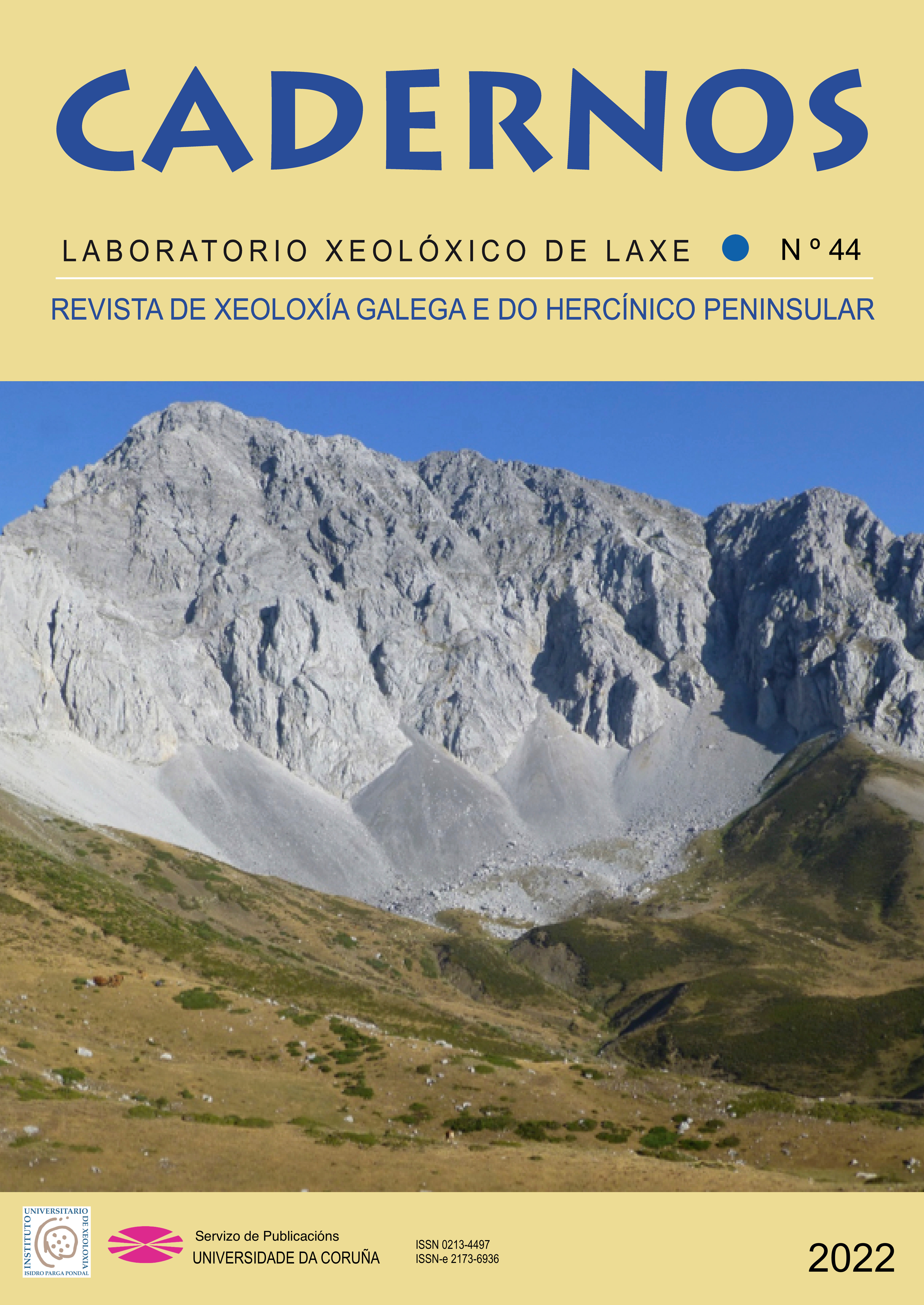Tourmalines in the Namacotche Li-Cs-Ta granitic pegmatite group, Mozambique: crystal chemistry and origin
Main Article Content
DOI:
https://doi.org/10.17979/cadlaxe.2022.44.0.9291Abstract
The field work, backscattered electron images and detailed microanalyses of three generations of tourmaline from the Namacotche LCT pegmatites allows de distinction between the compositional magmatic and hydrothermal tourmalines. The generation 1 occurs in the outer intermediate zone of the pegmatite. It consists of zoned crystals with an oscillatory inner core of foitite and schorl, an outer core of schorl and an Fe-rich fluor-elbaite rim. Unzoned Fe-rich fluor-elbaite crystals occur in the inner intermediate zone of the pegmatite. All the crystals are derived by fractionation of a (Al, Li, B)-rich pegmatite melt. However, the rim of zoned crystals and some compositions of unzoned crystals show evidence of hydrothermal fluids, as they plot outside the fractionation trends. The zoned fluor-elbaite crystals of the generation 2 are from the inner intermediate zone of the pegmatite. They have a pink core and a green rim. The rim has higher YFe2+, Na, F contents YFe2+/(YFe2++Licalc.) value and lower Si, YAl, Licalc. and X-site vacancy contents, X-vacancy/(Na+X-vacancy) value than the core. Both zones are hydrothermal. The rim is an overgrowth. The fluor-elbaite gemmy crystals of the generation 3 occur in sheared breccia blasts and clasts with a cookeite matrix. They depend mainly on the fluid-rich hydrothermal environment of low temperatures (280-150ºC). Some from the cycle a may result from the dissolution of magmatic tourmaline crystals of the generation 1 from the sheared outer and inner intermediate zones of the pegmatite due to reaction with late fluids in chemical disequilibrium, followed by growth of tourmaline with low temperature hydrothermal fluids. The evolution from the cycle a to the cycle b and to the cycle c of the generation 3 implies that the hydrothermal reacting fluids were undergoing fractionation and becoming richer in Li and poorer in Fe2+ during the late hydrothermal crystallization of the pegmatites.
Keywords:
Article Details
References
Aquater (1983) Cartografia geológica e prospecção mineira e geoquímica nas províncias de Nampula e Zambézia, I, II, III. Relatório Final. Unp. Report. DNG Library reference Nº 1244, Maputo.
Bosi, F., Lucchesi, S. (2007) Crystal chemical relationship in the tourmaline group: structural constraints on chemical variability. American Mineralogist 92, 1054–1063.
Braga, M., Leal Gomes, C., Duplay, J., Paquet, H. (2008) Clay minerals in the Namacotche Pegmatite Group from Zambezia Province, Mozambique: main constituents of late stage secondary paragenesis. Clay Minerals 43, 513–529.
Černý, P. (1982) Anatomy and classification of granitic pegmatites. In Granitic Pegmatites in Science and Industry (P. Černý, ed.). Mineral. Assoc. Can., Short Course Handbook 8, 1–39.
Černý, P., Ercit, T.S. (2005) The classification of granitic pegmatites revisited. Canadian Mineralogist 43, 2005–2026.
Dirlam, D.M., Laurs, B.M., Pezzotta, F., Simmons, W.B. (2002) Liddicoatite tourmaline from Anjanabonoina, Madagascar. Gems & Gemology 38, 28–53.
Dutrow, B.L., Henry, D.J. (2000) Complexy zoned fibrous tourmaline, Cruzeiro mine, Minas Gerais, Brazil: A record of evolving magmatic and hydrothermal fluids. Canadian Mineralogist 38, 131–143.
Dutrow, B.L., Henry, D.J. (2016) Fibrous tourmaline: a sensitive probe of fluid compositions and petrologic environments. Canadian Mineralogist 54, 311–335.
Foord, E.E. (1977) The Himalaya dike system, Mesa Grande District, San Diego County, California. Mineral Record 8, 461–474.
Francis, C.A., Dyar, M.D., Williams, M.L., Hughes, J.M. (1999) The occurrence of crystal structure of foitite from a tungsten-vein at Copper Mountain, Taos County, New Mexico. Canadian Mineralogist 37, 1431–1438.
Hawthorn, F.C., Henry, D.J. (1999) Classification of minerals of the tourmaline group. European Journal of Mineralogy 11, 201–215.
Henry, D.J., Dutrow, B.L., Selverstone, J. (2002) Compositional asymmetry in replacement tourmaline – an example from the Tauern Window, East Alps. Geological Materials Research 4, 1–18.
Henry, D.J., Novák, M., Hawthorne, F.C., Ertl, A., Dutrow, B.L. Uher, P., Pezzota, F. (2011): Nomenclature of the tourmaline – subgroup minerals. American Mineralogitst 96, 895–913.
Leal Gomes C. (2003a) As paragéneses correspondentes à mineralização em gemas dos pegmatitos LCT do Alto Ligonha-Mozambique (Análise dos locais chave, Nahia, Nahipa e Namacotche). Actas IV Congresso Ibérico de Geoquímica, Coimbra, 199–201.
Leal Gomes, C. (2003b) O papel dos fenómenos de evolução tardia na génese de gemas pegmatíticas – ilações da análise paragenética em pegmatitos LCT do Alto Ligonha (Moçambique). A Geologia de Engenharia e os Recursos Geológicos, Coimbra, Imprensa da Universidade, vol. II, 217–228.
Leal Gomes, C., Dias, P., Guimarães, F., Marques, J., Ferreira, J. (2006) Contrasting styles of Bi mineralization. Equilibrium and evolution in Zambezia Pegmatite Province, Mozambique. Proc. 21st Colloq. Afric. Geol., CAG Maputo, 3.
Leal Gomes, C., Marques, J., Dias, P., Costa, J.C. (2008) Análise descritiva das unidades portadoras de mineralização tantalífera em pegmatitos do sul da província Zambeziana (Moçambique). Proc. 5º Cong. Luso-Moçambicano de Engenharia, 2º Cong. Engenharia de Moçambique, Maputo, 1–23.
Peretti, A., Bieri, W.P., Reusser, E., Hametner, K. (2009) Chemical variations in multicolored “Paraiba-type" tourmalines from Brazil and Mozambique. Implications for origin and authenticity determination. Contributions to Gemology 9, 77 p.
Simmons, W.B. (2014) Gem-bearing pegmatites. In Geology of Gem Deposits, L.A. Groat (ed.), second edition, 9, 257–299. Short Course Series, vol. 44, Tucson, Arizona.
Simmons, W.B., Pezzotta, F., Shigley, J.E., Beurlen, H. (2012) Granitic pegmatites as sources of colored gemstones. Elements 8, 281–287.
Simmons, W.B., Webber, K.L., Falster, A.U., Nizamaff, J.W. (2001) Gem tourmaline chemistry and paragenesis. Australian Gemmologist 21, 24–29.
Tindle, A.G., Breaks, F.W., Selway, J.B. (2002) Tourmaline in petalite-subtype granitic pegmatites: evidence of fractionation and contamination from the Pakeagama Lake and Separation Lake areas of northwestern Ontario, Canada. Canadian Mineralogist 40, 753–788.
Wilson, B.S. (2014) Colored gemstones from Canada. In L.A. Groat (ed.). Geology of Gem Deposits, second edition, Short Course Series, vol. 44, chap. 11, 375–405, Tucson, Arizona.
Zhang, A.C., Wang, R.C., Jiang, S.Y., Hu, H. (2008) Chemical and textural features of tourmaline from the spodumene-subtype koktokay nº 3 pegmatite, Altai, Northwestern China: A record of magmatic to hydrothermal evolution. Canadian Mineralogist 46, 41–58.



